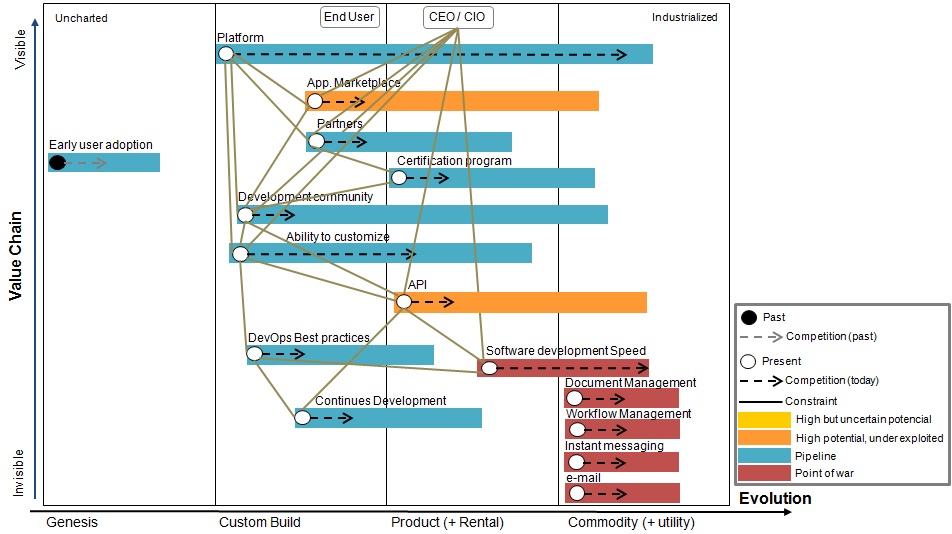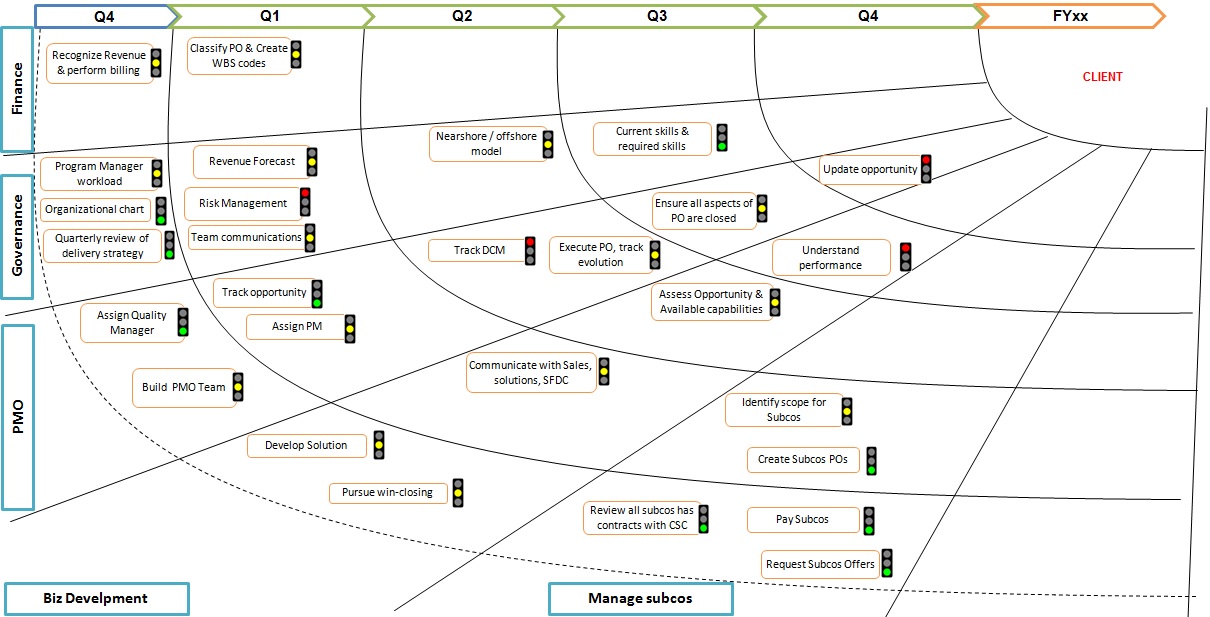I was recently asked about how to plan an strategic alignment between business and IT initiatives, where there should be a focus on the:
- Follow-up and efficiency of projects initiatives.
- Track of benefits realization.
- Portfolio plan where we all can understand the dependencies of the IT projects and impacts on business.
- Improve the level of knowledge of project managers.
My approach for this situation to define a set of actions at different levels:
- Strategic level: define vision, values, methods, objective and measures.
- Tactic level: define specific actions by area.
- Operational level: work on existing processes, put in place changes to them, increase the efficiency.
- Communicate, communicate, communicate.
- The methodology I would apply: Lean Six Sigma.
The summary of activities for the 100 days is:
- Day 1 – Let us be Honest
- Day 2 to Day 20 – Map it!
- Day 21 to Day 40 – Analyse & challenge
- Day 41 to Day 60 – Doctrine
- Day 61 to Day 80 – Flow
- Day 81 to Day 100 – Keep it steady
Let’s explain a little bit these steps:
Day 1 – Let us be Honest
- Describe the main pain points of the organization, areas where the communications are not good…
- Imagine the organization you would like to have: how the behavior should be, how the communications should be, what is the way IT should behave to satisfy the goals of the business, how business should behave to explain what they need to IT…
- Define KPIs and targets to these KPIs, so we can see how we evolve.
- Prepare a specific speech for each set of stakeholders about goals and benefits of your plan. The benefits of this speech have to be linked to the needs of the audience.
- Then communicate, communicate, communicate…
 Day 2 to Day 20 – Map it!
Day 2 to Day 20 – Map it!
- Draw the current situation you have on your systems.
- Discover with the different business units, how they are organized,
- Discover with IT what are the main IT assets, what are the projects on-going, and
- Capture a snapshot of the projects under execution and forecasted initiatives.
- Define a list of stakeholders.
- Start to draw a RACI chart with the main areas of work.
- Communicate, communicate, communicate…
 Day 21 to Day 40 – Analyze & challenge
Day 21 to Day 40 – Analyze & challenge
- It’s time to take the maps and draw more specific maps or diagrams about how the things are done.
- The diagrams have to be shared with the others, so people understand how things work (they are so useful, I have seen so much difference between how thinks work and how people believe that it works).
- Challenge to the people who owns a process to change/improve it: let’s run to simplicity!!!
- Identify duplication: they are there. Then remove it.
- Generate a common nomenclature that improve communications.
- Identify the hurdles and specific pain points the organization have. Analyze the impact on the organization.
- Deliver specific presentations to the different business departments and units with the specific actions to be done (action oriented & focus on their scope).
- For a business unit of a country, it should include the actions, the list of projects and the targets we have.
- For a global stakeholders, the report should include data at its level. It also should include the conflicts identified
- Communicate, communicate, communicate.
Day 41 to Day 60 – Doctrine
- You already have improved the situational awareness of the organization.
- Remove identified duplication of whatever you found.
- Work on the 20% more important pain points you have identified.
- Refine the ITIL processes, refine the RACI,
- Review the main IT projects.
- Launch with HR a training plan for PMs, so they can improve their skills.
- Mentor the PMs.
- Update with PMs the portfolio schedule: analyze the delays and their impacts, get the commitment of the delivery.
- And communicate, communicate, communicate: different stakeholders, different presentations.
Day 61 to Day 80 – Flow
- IT have their own flow: work on the existing projects, services…
- Business have their own intertia too.
- Push that this inertia goes where we all want to go.
- Understand that from IT we have a clear map about where we want to go technologically.
- Understand what are the future business challenges that business unit has. Force them to define it, help them to do it through business cases, impact analysis, proof of concepts…
- The reports needs to link the capabilities provided by the projects with the business capabilities the BU requires or needs to improve. Define in a measurable way the benefits. Typically the BPO owns the responsibility to measure the benefit.
Day 81 to Day 100 – Keep it steady
- You’re now ready to start examining structure, mechanisms of learning and the principles of strategic play.
- The maps will also help you identify where to attack along with where to gamble with respect competition.
- You have a list of pain points you have to work on.
- You have a list of KPIs and data about how it was done during these first 100 days.
- You have a portfolio schedule with linked initiatives.
- You have a detailed RACI with actions and new responsibilities for the organization.
- Follow-up the benefits realization of the projects.
- You have a more or less defined road-map of the business unit needs.
- You are discussing all the specific aspects with the specific stakeholders: action oriented, please, focus on actions.
 What happens after the 100 days?
What happens after the 100 days?
Ideally, you can do all this in a quarter, and after that repeat in the next quarter, so you are aligned with business changes, and you can also stop and gain perspective every 3 months. Do not lose perspective: the strategy needs to be review and aligned with the changes.
The approach during the second and other coming quarters have to be different. You can define:
- Weekly calls for operational aspects: issues, actions…
- Monthly calls: for project reviews, business unit reviews and tactic actions.
- quarterly calls: for business review at high level.
